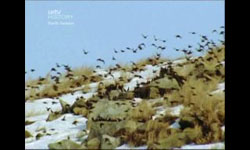Wildlife documentary looking in particular at the elusive Blue whale, and following a Grey Whale and her newborn calf as they are pursued by Killer whales
- Biology
- Environmental Studies
- No subtitles
- 46
Wildlife documentary looking in particular at the elusive Blue whale, and following a Grey Whale and her newborn calf as they are pursued by Killer whales
2007. A thousand metres down, in the twilight zone, animals play a constant game of hide and seek.
- Biology
- Environmental Studies
- No subtitles
- 46
2007. A thousand metres down, in the twilight zone, animals play a constant game of hide and seek.
2007. An unfortunate shoal of sardines is first attacked by three-metre-long striped marlin with metre-long, needle-sharp javelins on their heads. The commotion attracts juvenile yellowfin tuna and then a 14-metre Sei whale scoops up the remains.
- Biology
- Environmental Studies
- No subtitles
- 46
2007. An unfortunate shoal of sardines is first attacked by three-metre-long striped marlin with metre-long, needle-sharp javelins on their heads. The commotion attracts juvenile yellowfin tuna and then a 14-metre Sei whale scoops up the remains.
2007. In winter the temperature drops to below -50 degrees centigrade and in Antarctica most animals escape the weather. But emperor penguins stay put and huddle together, incubating their eggs and rearing their chicks in the worst weather on the planet. Weddell seals also remain, keeping their breathing holes open by scraping away the ice with their teeth.
- Biology
- Environmental Studies
- No subtitles
- 46
2007. In winter the temperature drops to below -50 degrees centigrade and in Antarctica most animals escape the weather. But emperor penguins stay put and huddle together, incubating their eggs and rearing their chicks in the worst weather on the planet. Weddell seals also remain, keeping their breathing holes open by scraping away the ice with their teeth.
This next instalment is about coral reefs, which are so crowded that they play host to a perpetual battle for space, even among the coral itself. It starts life as a larva that becomes a polyp. Having multiplied, it hardens into a limestone skeleton and grows to form a reef. As the community flourishes, animals develop relationships with one another and such a place can feature a huge variety of ocean life.
- Biology
- Environmental Studies
- No subtitles
- 11
This next instalment is about coral reefs, which are so crowded that they play host to a perpetual battle for space, even among the coral itself. It starts life as a larva that becomes a polyp. Having multiplied, it hardens into a limestone skeleton and grows to form a reef. As the community flourishes, animals develop relationships with one another and such a place can feature a huge variety of ocean life.
This programme surveys the effects of the seasons on the world's temperate seas — the most productive on Earth.
- Biology
- Environmental Studies
- No subtitles
- 11
This programme surveys the effects of the seasons on the world's temperate seas — the most productive on Earth.
2007. A huge tidal wave, sweeps 200 miles inland up the River Amazon. It's an event that only happens on key days each month, when the moon and sun combine their gravitational pull to maximum effect. The force of the wave shatters immense rainforest trees.
- Biology
- Environmental Studies
- No subtitles
- 46
2007. A huge tidal wave, sweeps 200 miles inland up the River Amazon. It's an event that only happens on key days each month, when the moon and sun combine their gravitational pull to maximum effect. The force of the wave shatters immense rainforest trees.
2007. Each year the entire population of green turtles that live off the coast of Brazil undertakes a massive 5,000-mile migration to the tiny seven-mile-wide island of Ascension, lost in the middle of the Atlantic.
- Biology
- Environmental Studies
- No subtitles
- 46
2007. Each year the entire population of green turtles that live off the coast of Brazil undertakes a massive 5,000-mile migration to the tiny seven-mile-wide island of Ascension, lost in the middle of the Atlantic.








